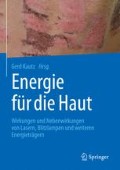Zusammenfassung
Kühlverfahren in der dermatologischen Lasertherapie ermöglichen Analgesie und Protektion der Epidermis. Es werden Kontaktkühlverfahren und kontaktlose Kühlverfahren unterschieden. Als Kühlmittel werden Flüssigkeiten, Festkörper und Gase verwendet. Die Auswirkungen von additiven Kühlverfahren auf die Clearance sind Gegenstand aktueller Forschungen. Um diese Aspekte dreht sich das vorliegende Kapitel.
Access this chapter
Tax calculation will be finalised at checkout
Purchases are for personal use only
Literatur
Adrian RM (1995) Cutaneous cooling facilitated high fluence pulsed dye laser therapy of port wine stains. Lasers Surg Med 6:76
Adrian RM, Tanghetti EA (1998) Long pulse 532-nm laser treatment of facial telangiectasia. Dermatol Surg 24: 1-4
Altshuler GB, Zenzie HH, Erofeev AV, Smirnov MZ, Anderson RR, Dierickx C (1999) Contact cooling of the skin. Phys Med Biol 44:1003-1023
Berlien HP, Waldschmidt J, Müller G (1987) Laser treatment of cutan and deep vessel anomalies. In: Waidelich W, Waidelich R (eds.) Laser 87 – Optoelectronics in medicine. Berlin, Heidelberg, New York: Springer:526-528
Biesman BS, Chang D, Richards S, Reinisch L (2002) A comparison of cold air vs. a thermoelectrically cooled sapphire window for epidermal protection. Lasers Surg Med (Suppl. 14): 36
Chang CJ, Kelly KM, Nelson JS (2001) Cryogen spray cooling and pulsed dye laser treatment of cutaneous hemangiomas. Ann Plast Surg 46:577-583
Chess C, Chess Q (1993) Cool laser optics treatment of large teleangiectasia of the lower extremities. J Dermatol Surg Oncol 19:74-80
Gilchrest BA, Rosen S, Noe JM (1982) Chilling port wine stains improves the response to argon laser therapy. J Plast Reconstr Surg 69:278-283
Greve B, Hammes S, Raulin C (2001) The effect of cold air cooling on 585 nm pulsed dye laser treatment of port-wine stains. Dermatol Surg 27: 633-636
Hammes S, Raulin C (2005) Evaluation of different temperatures in cold air cooling with pulsed-dye laser treatment of facial telangiectasia. Lasers Surg Med 36(2):136-140
Hammes S, Roos S, Raulin C, Ockenfels HM, Greve B (2007) Does dye laser treatment with higher fluences in combination with cold air cooling improve the results of port-wine stains? J Eur Acad Dermatol Venereol 21(9):1229-33
Hirsch RJ, Farinelli WA, Anderson RR (2002) A closer look at dynamic cooling. Lasers Surg Med (Suppl. 14): 36
Kauvar AN, Frew KE, Friedman PM, Geronemus RG (2002) Cooling gel improves pulsed KTP laser treatment of facial telangiectasia. Lasers Surg Med 30:149-153
Kelly KM, Nanda VS, Nelson JS (2002) Treatment of port-wine stain birthmarks using the 1.5-msec pulsed dye laser at high fluences in conjunction with cryogen spray cooling. Dermatol Surg 28: 309-313
Kelly KM, Nelson JS, Lask GP, Geronemus RG, Bernstein LJ (1999) Cryogen spray cooling in combination with nonablative laser treatment of facial wrinkles. Arch Dermatol 135:691-694
Knollmann BC, Berliner M (1990) Vergleichende Untersuchung zur Wirkung von drei verschiedenen Formen der Cryotherapie (Cryogelbeutel, Kaltluft und kalter Stickstoff) auf Hauttemperatur und Hautdurchblutung gesunder Probanden. Z Phys Med Baln Med Klim 19:225
Kröling P, Mühlbauer M (1992) Einfluß von Eisbeutel, Kaltluft und N2-Kaltgas auf die gelenknahe elektrische Schmerzschwelle. Phys Rehab Kur Med 2:1-6
Majaron B, Kelly KM, Park HB, Verkruysse W, Nelson JS (2001) Er:YAG laser skin resurfacing using repetitive long-pulse exposure and cryogen spray cooling: I. Histological study. Lasers Surg Med 28:121-30
Majaron B, Kimel S, Verkruysse W, Aguilar G, Pope K, Svaasand LO, Lavernia EJ, Nelson JS (2001) Cryogen spray cooling in laser dermatology: effects of ambient humidity and frost formation. Lasers Surg Med 28:469-476
Nelson JS, Milner TE, Anvari B, Tanenbaum BS, Kimel S, Svaasand LO, Jacques SL (1995) Dynamic epidermal cooling during pulsed laser treatment of port wine stains. Arch Dermatol 131:695-700
Ott KD (1991) Kaltlufttherapie. Physiotherapie 82:231-232
Pfefer TJ, Smithies DJ, Milner TE, van Gemert MJC, Nelson JS, Welch AJ (2000) Bioheat transfer analysis of cryogen spray cooling during laser treatment of port wine stains. Lasers Surg Med 26:145-57
Raulin C, Grema H (2004). Single-pass carbon dioxide laser skin resurfacing combined with cold-air cooling: efficacy and patient satisfaction of a prospective side-by-side study. Arch Dermatol 140(11):1333-1336
Raulin C, Greve B (2003) Laser und IPL-Technologie in der Dermatologie und Ästhetischen Medizin. Schattauer, Stuttgart, New York
Raulin C, Greve B, Hammes S (2000) Cold air in laser therapy: First experiences with a new cooling system. Lasers Surg Med 27:404-410
Raulin C, Karsai S (2013). Lasertherapie der Haut. Springer Heidelberg
Tiel H, Drosner M, Hebel T, Raulin C (1998) New cooling technique for pulsed lasers or intensive light sources. Lasers Surg Med 22(suppl. 10):77
Torres JH, Tunnell JW, Pikkula BM, Anvari B (2001) An analysis of heat removal during cryogen spray cooling and effects of simultaneous airflow application. Lasers Surg Med 28:477-486
Waldorf HA, Alster TS, McMillan K, Kauvar AB, Geronemus RG, Nelson JS (1997) Effect of dynamic cooling on 585-nm pulsed dye laser treatment of port wine stain birthmarks. Dermatol Surg 23: 657-662
Werner JA, Lippert BM, Godbersen GS, Rudert H (1992) Die Hämangiombehandlung mit dem Neodym:Yttrium-Aluminium-Granat-Laser (Nd:YAG-Laser). Laryngo Rhino Otol 71:388-395
Werner JA, Lippert BM, Hoffmann P, Rudert H (1995) Nd:YAG laser therapy of voluminous hemangiomas and vascular malformations. Adv Otorhinolaryngol 49:75-80
Zenzie HH, Altshuler GB, Smirnov MZ, Anderson RR (2000) Evaluation of cooling methods for laser dermatology. Lasers Surg Med 26:130-134
Author information
Authors and Affiliations
Editor information
Editors and Affiliations
Rights and permissions
Copyright information
© 2018 Springer-Verlag GmbH Deutschland, ein Teil von Springer Nature
About this chapter
Cite this chapter
Hammes, S. (2018). Kühltechniken. In: Kautz, G. (eds) Energie für die Haut. Springer, Berlin, Heidelberg. https://doi.org/10.1007/978-3-662-56436-3_35
Download citation
DOI: https://doi.org/10.1007/978-3-662-56436-3_35
Publisher Name: Springer, Berlin, Heidelberg
Print ISBN: 978-3-662-56435-6
Online ISBN: 978-3-662-56436-3
eBook Packages: Medicine (German Language)

